This article was published as a part of the Data Science Blogathon.
Introduction
In addition to socializing with pals, humans are addicted to their smartphones. We primarily communicate via social media, such as WhatsApp, Facebook, Telegram, Instagram, and many others. It’s always interesting to see how people start using technology on social media platforms. Especially because it is a very simple pattern to understand. Recently BOT concepts have been used for many purposes, and it touches upon Artificial Intelligence patterns; as many are started learning Data Science, I thought to share my experience with the BOT concept. So I preferred the Telegram app, as I discovered it has numerous advantages over other apps in terms of entertainment, professionalism, academics, and other areas. This article will show how to create a Telegram BOT using Python programming language. We will also see how to get the bot up and running on our machine.
Table of contents
What is a BOT?
BOT, or “bots,” are computer programs that automate tasks on the internet. They can be used for various purposes, from interacting with customer service to handling large amounts of data. Bots can be used to save time and increase efficiency, and they’re becoming more and more common on the internet. It can help to increase efficiency by performing specific tasks automatically. They can be used to perform simple or complex tasks, such as communicating with other bots, parsing and understanding data, or undertaking tasks on a user’s behalf. Bots can be used for various purposes, such as customer service, marketing, and even automating tasks in the workplace.
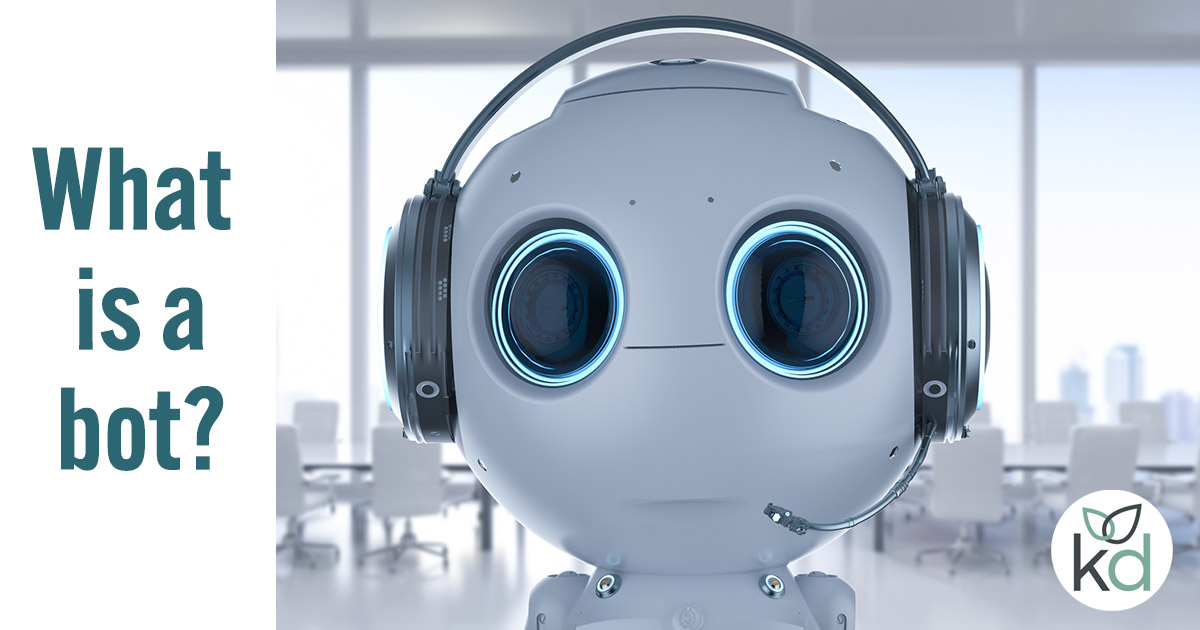
Source – kaydee.net
What is the Use of BOT?
As the internet has become more prevalent, so too has the use of bots. Bots are software programs that allow you to automate repetitive tasks on the internet. BOTs can be a great way to save time and money.
There are several reasons why you might want to use a bot. For example, you might use a bot to bulk-download files from the internet. Or you might use a bot to automate a task you frequently do on the internet.
What are the Different Formats of BOT?
There are different types of BOTs, each with its strengths and weaknesses.
Natural language processing (NLP) bots can understand and respond to human commands in natural language. As a result, they can be used for various tasks, such as customer service, data entry, and automated marketing.
Robo-advisors are computer programs that provide financial advice to individual investors. They use artificial intelligence (AI) to analyze historical stock data, investment returns, and other market factors to give personalized investment advice.
Chatbots are computer programs that can hold a conversation with a human user. They can be used for various tasks, such as customer service, data entry, and automated marketing.
Virtual assistants are computer programs that can perform various tasks, such as finding information, making reservations, and managing your calendar. They use artificial intelligence (AI) to understand and respond to human commands in natural language.
What are the Types of BOT?
There are a few different types of bots. The first type of bot is a chatbot. Chatbots are computer programs that you can talk to. They can help you with tasks like booking a hotel or ordering food.
The second type of bot is a machine learning bot. Machine learning bots are different from chatbots because they can learn independently. For example, they can know how to book hotels or order food.
The third type of bot is a customer service bot. The term “customer service bot” has a few different meanings. Sometimes, a customer service bot is a software application that provides customer service support. These bots can answer questions, handle complaints, and help with customer service interactions.
Another meaning of a customer service bot is a chatbot that conversationally interacts with customers. These bots can provide customer service support, answer customer questions, and provide recommendations.
BOT vs. AI:
Bots are computer programs that automate customer service or content creation tasks. AI is a broader term that includes all the technologies used to create intelligent machines. Bots are a rapidly expanding field that combines artificial intelligence with computer programming to create compelling customer service, content creation, and much more. They can do things humans can’t, like understanding language, recognizing images, and more. Many companies are creating bots and platforms where people can interact with bots. Platforms such as Amazon Alexa or Apple Siri enable users to execute commands by talking to a bot.
Advantages & Disadvantages of BOT:
There are many advantages to using BOT technology in a business. One of the most important advantages is that BOT technology can help you automate tasks that human employees traditionally carry out. This can save you a lot of time and money. BOT technology can also help you to improve your business efficiency by carrying out repetitive tasks automatically. It can also help you to improve your customer service by handling customer inquiries automatically.
One of the disadvantages of BOTs is that they are not as autonomous as human beings. They cannot make independent decisions and can be controlled by their creators. This makes them vulnerable to being used for malicious purposes. Additionally, BOTs are not as effective as human beings at processing information and are, therefore, not as efficient at carrying out tasks.
What is the need for Telegram Bot?
Telegram is a messaging app with a focus on security and speed. It’s free, secure, and easy to use. You can send and receive messages, photos, and videos from anyone worldwide. Telegram also offers a range of features not available in other messaging apps, like group chats, stickers, and voice calls. Telegram is available on various devices, including PCs, smartphones, and tablets. It has a unique approach to communication that allows you to send and receive messages without opening a separate app. In addition, telegram is a bot platform that makes it easy to create and manage bots.
Telegram BOT is a new way to communicate with your friends and family. Telegram BOT can send and receive messages, photos, videos, and stickers. You can also use Telegram BOT to find information and make requests.
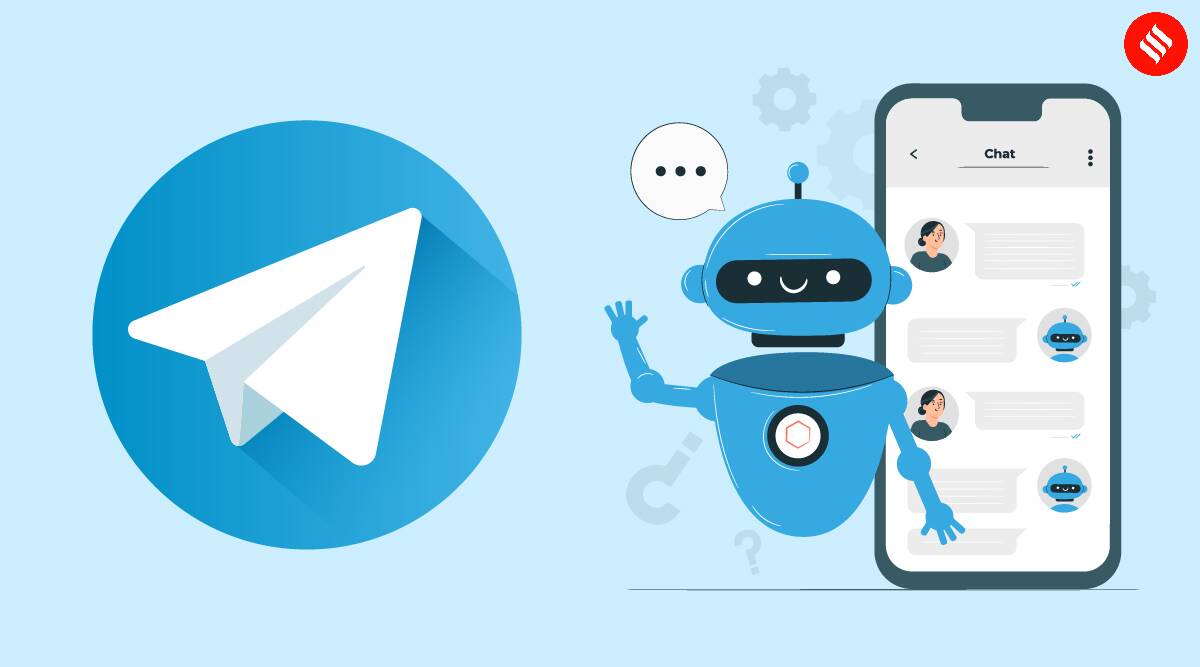
Image Source: https://indianexpress.com/article/technology/techook/what-are-telegram-bots-and-how-to-use-them-8258704/
How to Create Telegram BOT using Python?
Creating Telegram BOT using python, consists of two main steps,
1. Getting Tokens and creating a BOT user from the Telegram app
2. Synchronizing and adding functionalities with Python code
So in the following, we can see about these two steps more elaborately,
1. Getting Tokens and creating a BOT user from the Telegram app
One of the main advantages of Python programming language is the library; with the help of a third-party library, we can make wonders. Here for creating Telegram BOT, we are using some basic libraries,
Step 1: Installing libraries:
Open Anaconda Prompt or command prompt and then install this pre-request library for developing BOT in the Telegram application as shown in the picture,
!pip install python-telegram-bot

Step 2: To get the API key for the BOT:
We need to open the Telegram Desktop version or APP version, then search for ‘BotFather’ with the verified symbol as shown in the figure, then proceed with the START option in that BOT,
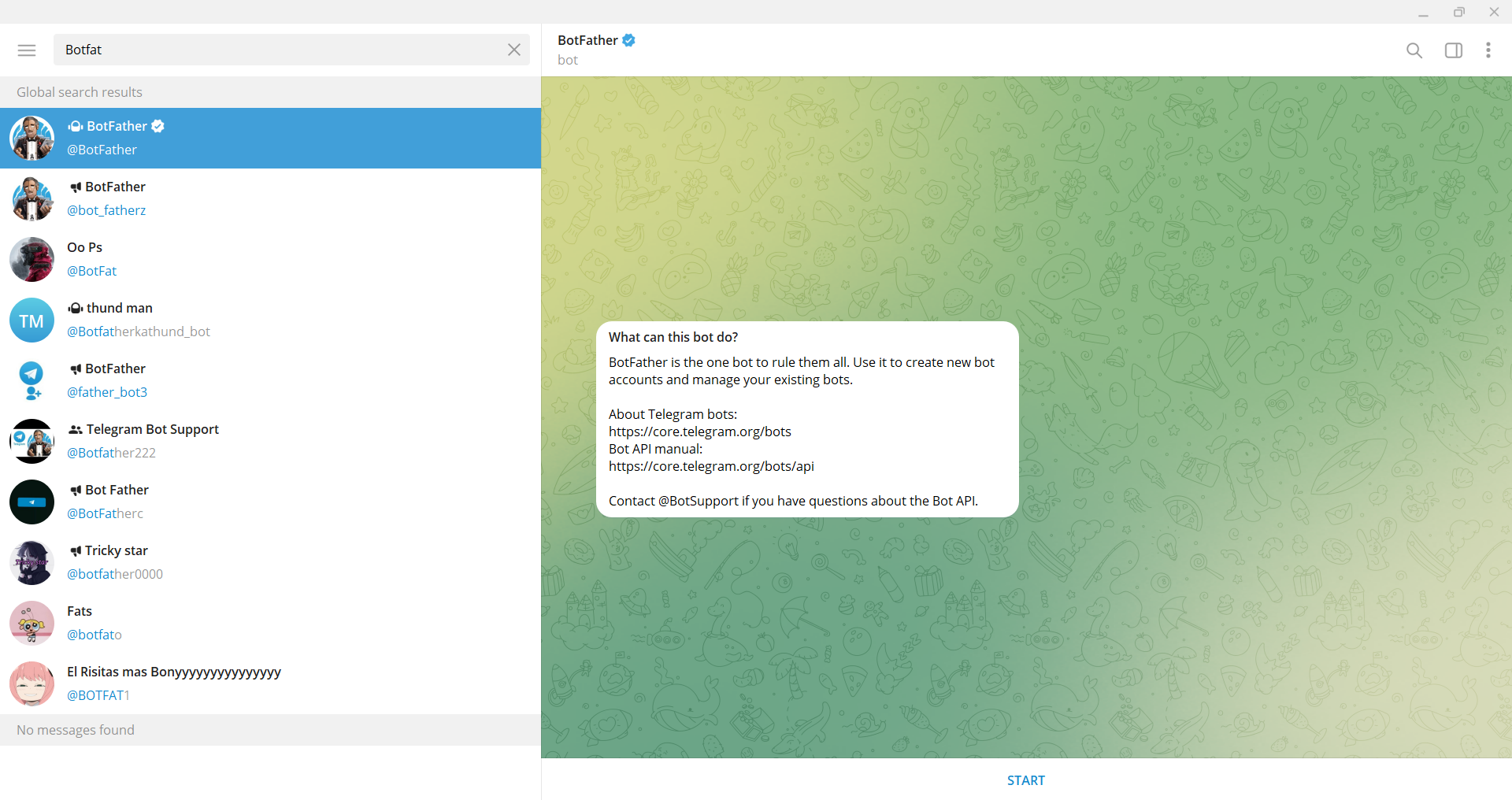
Step 3: Then you get multiple options, as shown in the picture below:
As our primary purpose of this project is to develop Telegram BOT, choose the option /newbot or type /newbot for further process.
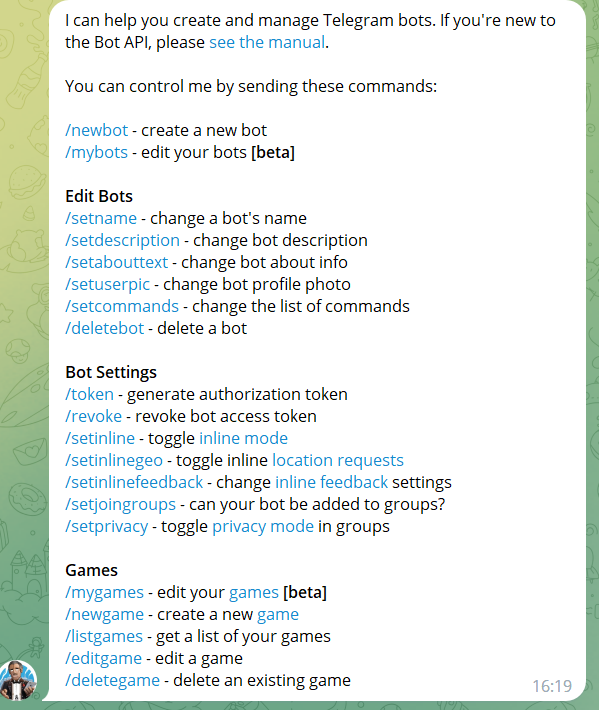
Step 4: Creating Telegram BOT and getting TOKEN from Telegram App:
After we type /newbot, it will ask for the username for the BOT. First, we need to give as per the application or website based or anything, as shown in the picture, then we need to create the bot name with either the title should have xxxxBOT or xxx_bot in. Either way, we can give. It can be any combination of alphabet or numerals with special characters.

Now we successfully created the link and username of Telegram BOT; also, we got the token API for creating BOT, as shown in the picture.
Step 5: For privacy setup in Telegram:
We need to set the privacy, which means apart from us, no other person can use the API key, so we need to DISABLE the process so that we can be the sole authority for this BOT; others cannot be able to do any alteration or hacking kind of thing,
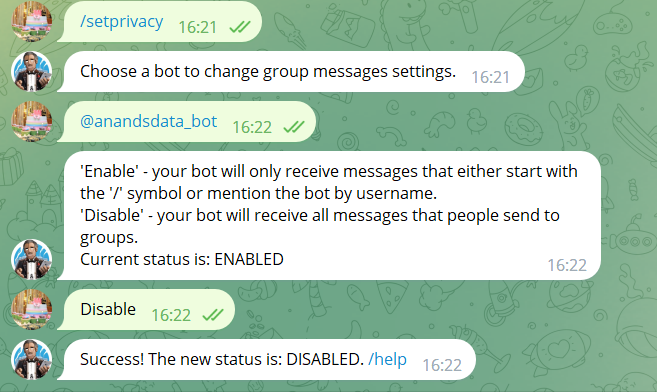
With this, we finished the Telegram side process and proceeded with Python.
2. Synchronizing and adding functionalities with Python code
Importing basic libraries,
from telegram.ext.updater import Updater from telegram.update import Update from telegram.ext.callbackcontext import CallbackContext from telegram.ext.commandhandler import CommandHandler from telegram.ext.messagehandler import MessageHandler from telegram.ext.filters import Filters
The next step is to set the API key for creating and updating the functionalities,
#initialize API token - Telegram
telegram_token = 'API Key paste it here
#creating objects to perform a task
updater = Updater('API key paste it here, use_context=True)
dispatcher = updater.dispatcher
The next step is to create the functionalities that we need to display in the Telegram BOT,
#creating functionalities
def start(update, context):
update.message.reply_text('Hello! Welcome to anandsdata BOT! Enjoy the resource!')
update.message.reply_text('Type /help for the content to display!')
update.message.reply_text('Happy Learning!')
def help(update, context):
update.message.reply_text(
"""
/start -> Welcome to the anandsdata BOT!
/help -> This particular message
/Python_udemy1 -> Python weblink with certification by Kirill Eremenko
/Python_udemy2 -> Python and projects, weblink with certification by Dr Angelina
/Python_YT -> Python weblink youtube by Dr Chunk
/Python_series -> My YouTube channel about Python series
/Python_blog -> Python Blog material
/DataScience_blog -> Data Science blog material
/analytics_blog -> Blogs wrt data science in Analytics Vidya
/Scribbling_blog -> Scribbling blog material
/github_repo -> Github repository
/SQL -> materials for SQL
/contact -> contact information
""")
The next step is to give the links or other information that is correlated with the above options,
def Python_udemy1(update, context):
update.message.reply_text('Udemy link: https://www.udemy.com/course/machinelearning/')
def Python_udemy2(update, context):
update.message.reply_text('Udemy link: https://www.udemy.com/course/100-days-of-code/')
def Python_YT(update, context):
update.message.reply_text('YouTube link: https://www.youtube.com/watch?v=8DvywoWv6fI&t=21928s')
def Python_series(update, context):
update.message.reply_text('YouTube link: https://www.youtube.com/playlist?list=PL_MPYn9hN7UrS5bfykD5yba-HSdHEfWsn')
def Python_blog(update, context):
update.message.reply_text('My blog link: https://www.anandsdata.com/blog/categories/python')
def DataScience_blog(update, context):
update.message.reply_text('My blog link: https://www.anandsdata.com/blog/categories/data-science')
def analytics_blog(update, context):
update.message.reply_text('My Analytics Vidya link: https://www.analyticsvidhya.com/blog/author/premanand17/')
def Scribbling_blog(update, context):
update.message.reply_text('My Scribblings or thoughts in TAMIL link: https://www.anandsdata.com/blog/categories/snippet')
def github_repo(update, context):
update.message.reply_text('My GitHub repository link: https://github.com/anandprems?tab=repositories')
def SQL(update, context):
update.message.reply_text('YouTube link: https://www.youtube.com/watch?v=HXV3zeQKqGY')
def contact(update, context):
update.message.reply_text('Blog link: https://linktr.ee/anandsdata')
Lastly, we need to update the functionalities with the commands we need to give it in BOT,
dispatcher = updater.dispatcher
updater.dispatcher.add_handler(CommandHandler('start', start))
updater.dispatcher.add_handler(CommandHandler('help', help))
updater.dispatcher.add_handler(CommandHandler('Python_udemy1', Python_udemy1))
updater.dispatcher.add_handler(CommandHandler('Python_udemy2', Python_udemy2))
updater.dispatcher.add_handler(CommandHandler('Python_YT',Python_YT))
updater.dispatcher.add_handler(CommandHandler('Python_series',Python_series))
updater.dispatcher.add_handler(CommandHandler('Python_blog',Python_blog))
updater.dispatcher.add_handler(CommandHandler('DataScience_blog',DataScience_blog))
updater.dispatcher.add_handler(CommandHandler('analytics_blog',analytics_blog))
updater.dispatcher.add_handler(CommandHandler('Scribbling_blog',Scribbling_blog))
updater.dispatcher.add_handler(CommandHandler('github_repo',github_repo))
updater.dispatcher.add_handler(CommandHandler('SQL',SQL))
updater.dispatcher.add_handler(CommandHandler('contact',contact))
updater.start_polling() # Start the bot
updater.idle() # Wait for the script to be stopped; this will stop the bot
Finally, the Telegram BOT looks like this,
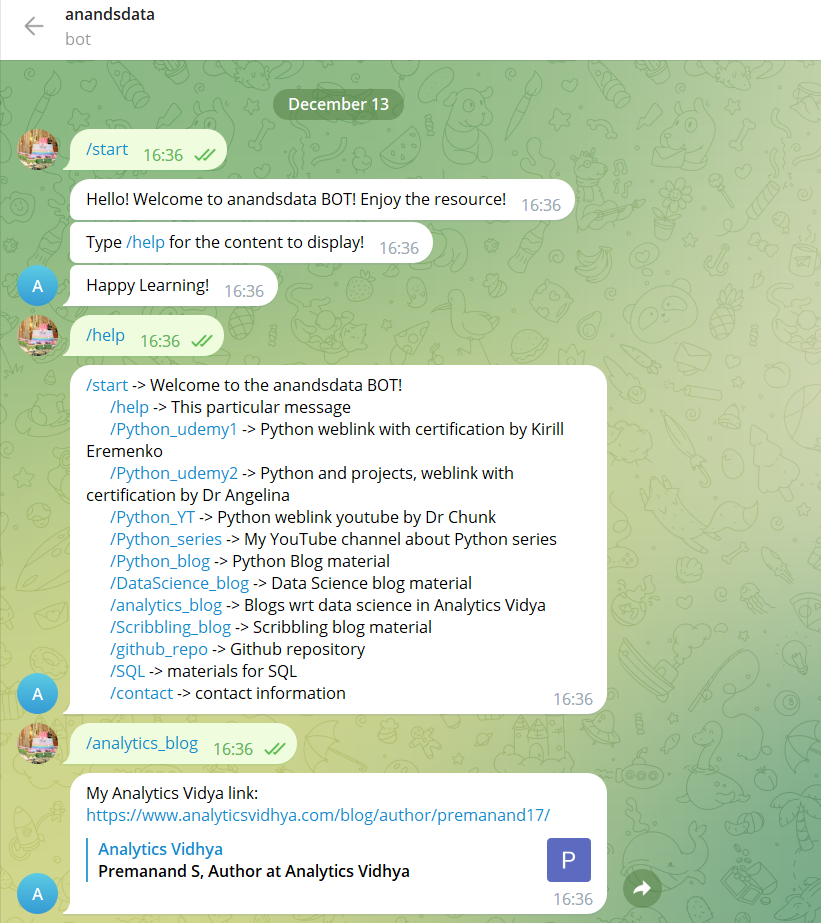
Frequently Asked Questions
A. To automate Telegram using Python, you can use the python-telegram-bot library. Install it using pip, create a bot on Telegram using BotFather, and obtain the bot token. Use the library’s API to interact with Telegram, send and receive messages, and perform actions. Implement your desired automation logic using Python code and run it to automate your Telegram bot.
A. Yes, creating a Telegram bot is relatively easy. Telegram provides a dedicated BotFather bot that allows you to create and manage bots. You can interact with BotFather to create a new bot, set its name, username, and obtain a unique API token. Once you have the token, you can use it to authenticate and interact with the Telegram Bot API using Python or any other programming language.
Conclusion:
I hope it helped the readers understand how to create Telegram BOT using Python programming language, with the help of Token generated by our Telegram user. The BOT concept can be used for many customer service applications. Here I have created with the small intention of sharing useful information to prepare Data Science weblinks and share my website. If you are a YouTuber or blogger, you can customize the above steps accordingly. Takeaway points from this article are as follows,
– Step-by-step procedure for creating Telegram Bot from Telegram App
– How to get the API key for creating Telegram BOT?
– Libraries essential for Telegram BOT
– How to create and update the functionalities needed for Telegram BOT?
– How to launch the Telegram BOT?
I hope the readers can understand the idea behind Telegram BOT by using Python programming.
The media shown in this article is not owned by Analytics Vidhya and is used at the Author’s discretion.



